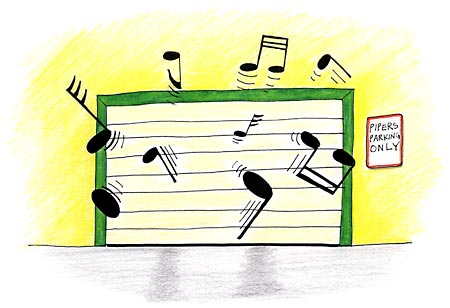  |
||
 |
 |
 |
 |
 |
||
| reference articles | competition journal | piping links | FAQ | contact me |
Andrew's Tips: Where to Practice with BagpipesBy Andrew T. Lenz, Jr., Santa Cruz, California, ©2008-2011
Even those with the most cursory knowledge of the Great Highland Bagpipes are aware that they are very loud instruments. This provides pipers with a challenge not often found with other less booming instruments, that is, finding a place to practice where your playing won't annoy anyone else. Finding a place to practice using the relatively quiet practice chanter is comparatively easy, but where does one practice with a full set of pipes? As a new piper, I remember hearing or reading stories of the sound of bagpipes carrying for several miles under ideal conditions. In the dead of night, I can hear sea lions bark from well over two miles away. A sea lion bark when measured from about 2 meters, ranges from about 90-105 dB and while we're talking a different range of frequencies, this volume is similar to that of a set of Great Highland Bagpipes. Pipes heard from a couple of miles? I believe it's plausible. We'll discuss some possible practice spots. HOME Sound is in many ways like water—if there's any gap, it'll get out. If you are looking to soundproof a room (or a garage), you have a to seal every possible way for air to escape. After sealing, the next concern is insulation, for example, if you have a perfectly sealed thin metal box, the walls will absorb but reemit the sound—you need something to absorb the sound energy and turn it into some other form of energy, namely, heat. You need your practice space to be sound sealed and sound insulated. You first step is to select your room and if you aren't sure if sound emanating is still too loud, just ask someone to go out and listen while you play then ask for their thoughts. You can repeat this after you take steps to soundproof your room to gauge their effectiveness. If you have a the money, time, and the room, you can build a sealed and insulated enclosure somewhere within your house or apartment. This method is known as "room-within-a-room" and is sometimes abbreviated "RWAR." This works by a process called "acoustic de-coupling" whereby the sound waves "have the bridge removed and they have to swim across" to continue to propagate. You'd also want to insulate the interior of this special room to control echos. The problem with a simple RWAR is there is no air circulation, so it will build up heat and carbon dioxide as you use it. If you get really fancy you can install a fan with an insulated duct with at least one right angle to act as a baffle. Constructing a RWAR can get fairly complex, and if you wish to pursue it as a possible solution, there are plenty of articles on the Web about it. For the rest of us with limited money, time, and/or room, we can often make do with the existing structure of our homes. A centrally located room or large closet with no exterior walls (i.e., there's another of your rooms on the other side of all the walls) can often serve, as will a basement. A garage is usually the worst place to keep your playing a secret since it's typically poorly insulated. If it's a room, weather strip the door and make sure it latches snugly. You might consider installing a solid-core door. Stuff a towel at the base of the door. Close any drapes or curtains over the closed windows, and if possible, those windows should be double-paned. For extra help, you can secure a heavy blanket or curtain over any windows; Velcro around the perimeter makes for a better seal. Or if you are making a more permanent dedicated space, board up the windows with drywall and sandbags (or mineral wool a.k.a. rock wool, or Owens Corning 703 Fiberglass—you'll want to cover any raw fiberglass product with fabric). Or you can put up acoustic panels such as those included in the Auralex Studiofoam Designer Kit. If you have no choice but to share your home practice time with, say, family members, consider passing out some comfortable earplugs... you'll need some understanding and cooperative people though! If your home doesn't fit the bill, you might consider approaching neighbors, relatives, and friends for a possible practice space. Or more drastically, you could consider moving to a less-populated area. OUTDOORS It may be tempting to play on a golf course, at a park, or at athletic fields, but remember that those pipes carry for quite a ways in wide open spaces, so consider that in your selection. Cemeteries can be a good spot, since the sound of pipes is not going to be unexpected, just don't interrupt a funeral service! If you live near a shoreline away from people, this could work for you. "I'm having no luck so far!" After exhausting homes and other most convenient spots, talk to your instructor or other pipers in your area. Experienced pipers (such as those in a band) may have ideas for good practice spots. Failing that, you can approach schools, businesses, churches, and community groups. If payment is requested, sometimes you can successfully trade a performance or a demonstration for use of their space. SCHOOLS WORK CHURCH LIBRARY COMMUNITY RESTAURANT OR PUB VEHICLES RENTAL
Regardless of where you end up practicing on a full set of pipes, considering that many pipers even wear earplugs outdoors, especially remember to wear earplugs if you are playing in a small enclosed space. If you just can't find somewhere to practice.
If you have comments or suggestions about this page, please contact me. This page last updated Sunday, May 29, 2011. |
| sitemap | ||


